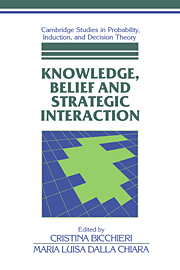Book contents
- Frontmatter
- Contents
- Preface
- List of contributors
- 1 Feasibility
- 2 Elicitation for games
- 3 Equilibrium, common knowledge, and optimal sequential decisions
- 4 Rational choice in the context of ideal games
- 5 Hyperrational games: Concept and resolutions
- 6 Equilibria and the dynamics of rational deliberation
- 7 Tortuous labyrinth: Noncooperative normal-form games between hyperrational players
- 8 On consistency properties of some strongly implementable social choice rules with endogenous agenda formation
- 9 Algorithmic knowledge and game theory
- 10 Possible worlds, counterfactuals, and epistemic operators
- 11 Semantical aspects of quantified modal logic
- 12 Epistemic logic and game theory
- 13 Abstract notions of simultaneous equilibrium and their uses
- 14 Representing facts
- 15 Introduction to metamoral
- 16 The logic of Ulam's games with lies
- 17 The acquisition of common knowledge
- 18 The electronic mail game: Strategic behavior under “almost common knowledge”
- 19 Knowledge-dependent games: Backward induction
- 20 Common knowledge and games with perfect information
- 21 Game solutions and the normal form
- 22 The dynamics of belief systems: Foundations versus coherence theories
- 23 Counterfactuals and a theory of equilibrium in games
16 - The logic of Ulam's games with lies
Published online by Cambridge University Press: 05 November 2011
- Frontmatter
- Contents
- Preface
- List of contributors
- 1 Feasibility
- 2 Elicitation for games
- 3 Equilibrium, common knowledge, and optimal sequential decisions
- 4 Rational choice in the context of ideal games
- 5 Hyperrational games: Concept and resolutions
- 6 Equilibria and the dynamics of rational deliberation
- 7 Tortuous labyrinth: Noncooperative normal-form games between hyperrational players
- 8 On consistency properties of some strongly implementable social choice rules with endogenous agenda formation
- 9 Algorithmic knowledge and game theory
- 10 Possible worlds, counterfactuals, and epistemic operators
- 11 Semantical aspects of quantified modal logic
- 12 Epistemic logic and game theory
- 13 Abstract notions of simultaneous equilibrium and their uses
- 14 Representing facts
- 15 Introduction to metamoral
- 16 The logic of Ulam's games with lies
- 17 The acquisition of common knowledge
- 18 The electronic mail game: Strategic behavior under “almost common knowledge”
- 19 Knowledge-dependent games: Backward induction
- 20 Common knowledge and games with perfect information
- 21 Game solutions and the normal form
- 22 The dynamics of belief systems: Foundations versus coherence theories
- 23 Counterfactuals and a theory of equilibrium in games
Summary
Someone thinks of a number between one and one million
(which is just less than 220).
Another person is allowed to ask up to twenty questions,
to each of which the first person is supposed to answer only yes or no.
Obviously the number can be guessed by asking first:
Is the number in the first half million?
then again reduce the reservoir of numbers in the next question
by one-half, and so on.
Finally the number is obtained in less than log2(1000000).
Now suppose one were allowed to lie once or twice,
then how many questions would one need to get the right answer?
S. M. Ulam (1976), Adventures of a Mathematician (New York: Scribner, p. 281)PLAYING ULAM'S GAME
The questions and answers exchanged between Questioner and Responder in Ulam's game with k lies are propositions. In this chapter we show that the Lukasiewicz (k + 2)-valued sentential calculus ([14], [15]) provides a natural logic for these propositions. Throughout this chapter, the Responder is identified with Pinocchio. Author and Reader will often impersonate the Questioner. Unless otherwise stated, in this section we consider Ulam's game with at most one lie.
Initially, Pinocchio and the Questioner agree to fix a search space S = {0,1, …, 2n – 1}. Writing numbers in binary notation, S is more conveniently represented by the n-cube {0, l]n.
- Type
- Chapter
- Information
- Knowledge, Belief, and Strategic Interaction , pp. 275 - 284Publisher: Cambridge University PressPrint publication year: 1992
- 39
- Cited by

